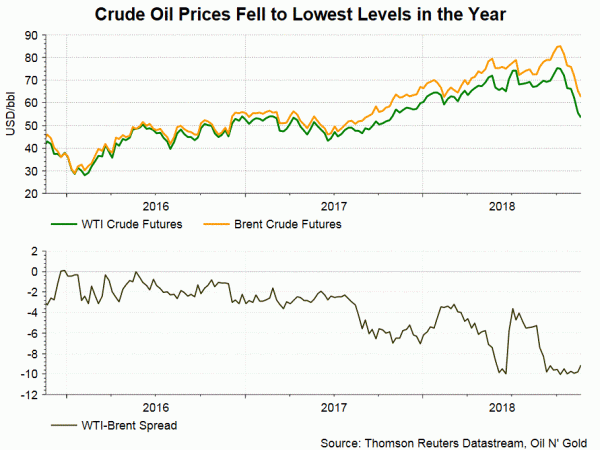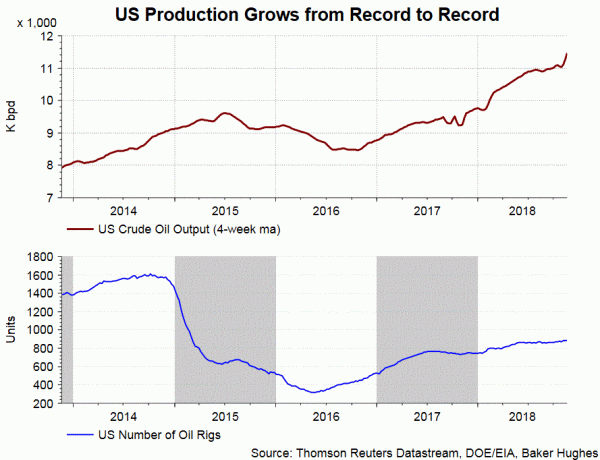Crude oil prices have declined for 6 consecutive weeks. A confluence of factor has triggered the sharp selloff: concerns that the slowdown of Chinese economic growth would accelerate, reports that Russia would not join OPEC to cut output further, Trump called for Saudi Arabia to raise output, news of possible concession on Iranian sanctions. All these factors can be summarized in a demand/ supply relation.
In the November updates released by the three major agencies: the US Energy Information Agency (EIA), the Paris-based International Energy Agency (IEA) and OPEC, all incorporated a gloomier outlook for the demand and supply balance. What’s common in these updates are downgrade in oil demand and upward revisions in oil supply. Meanwhile, all upgraded their US crude oil production forecasts.
The EIA forecast world oil demand to increase +1.52M bpd to 100M bpd in 2018 before rising +1.44M bpd to 102M bpd in 2019. The estimate for next year is -0.1M bpd lower than last month’s. OPEC raised its projection for this year to 98.79M bpd, marking a +1.5M bpd increase from 2017’s demand and a +0.59M bpd upward revision from last month’s forecast. Yet, the cartel cut its expectation for next year’s demand, by -0.2 M, bpd to 100M bpd. The IEA left its forecasts for both years unchanged at 99.2M bpd and 101M bpd, respectively.
Global Oil Supply
The EIA forecast non-OPEC oil supply to increase +2.56 M bpd to 61M bpd in 2018 before rising +2.38M bpd to 63.4M bpd in 2019. These estimates represent upward revisions of +2.58M bpd and +0.66M bpd, from last month’s forecasts. OPEC raised its projection for this year to 59.89M bpd, marking a +2.31M bpd increase from 2017’s output and a +0.01M bpd upward revision from last month’s forecast. Non-OPEC output for 2019 would reach 62.1M bpd, up +0.01M bpd for last month’s forecast. The IEA expects non-OPEC output would increase+0.6M bpd to 58M bpd in 2018, down -0.1M bpd from last month’s projection. Output in 2019 is revised higher , by +0.1M bpd to 59.6M bpd. As a result of lower demand and higher non-OPEC production, demand for OPEC’s oil should reduce. Both EIA and OPEC expect the cartel should supply around 32.5M bpd and 31.5M bpd of oil to the market this year and next year, respectively. That is, if the OPEC members produce according to their assigned quota set last year (32.5-33M bpd), this would roughly match with market demand, or with a little surplus, this year.
Yet, recent data suggest that many members have produced more than their quota. Reuter’s estimate shows that OPEC’s output soared to the highest since 2016 in October. The cartel in total produced 33.31M bpd last month, up +0.39M bpd from September. Lack of compliance or putting an end to the output cut deal would exacerbate the oversupply situation next year.
US Oil Production
The increase in non-OPEC has been driven by the US, thanks to shale exploration in recent years. The EIA expects US crude oil production would average at 10.9M bpd this year, and then rise to 12.1M bpd in 2019. Both figures were revised higher from last month’s forecasts













